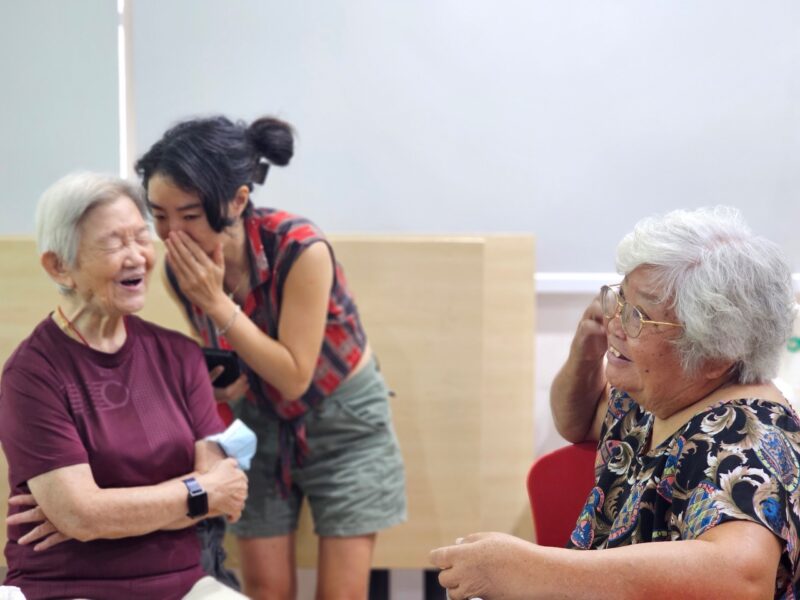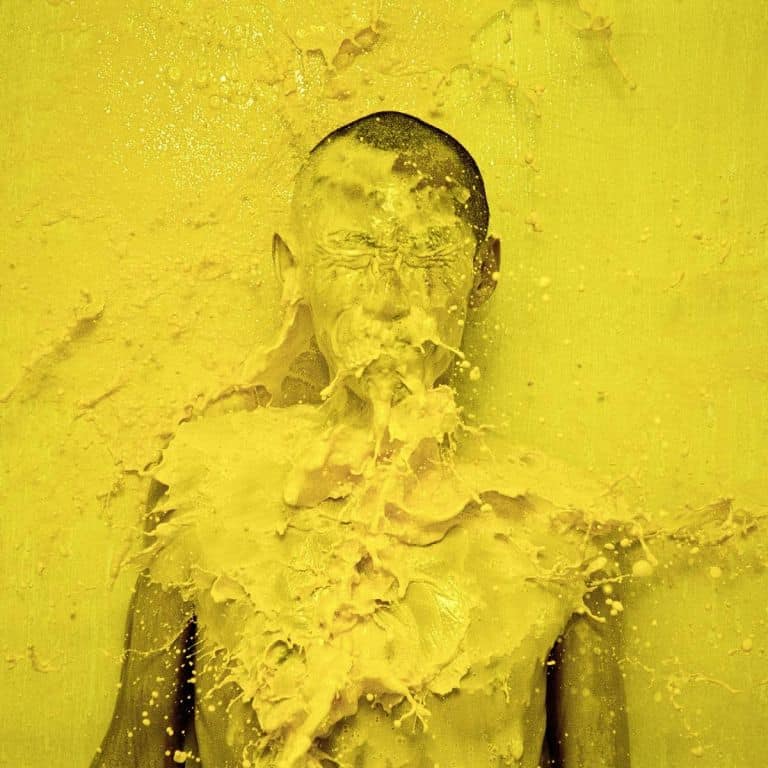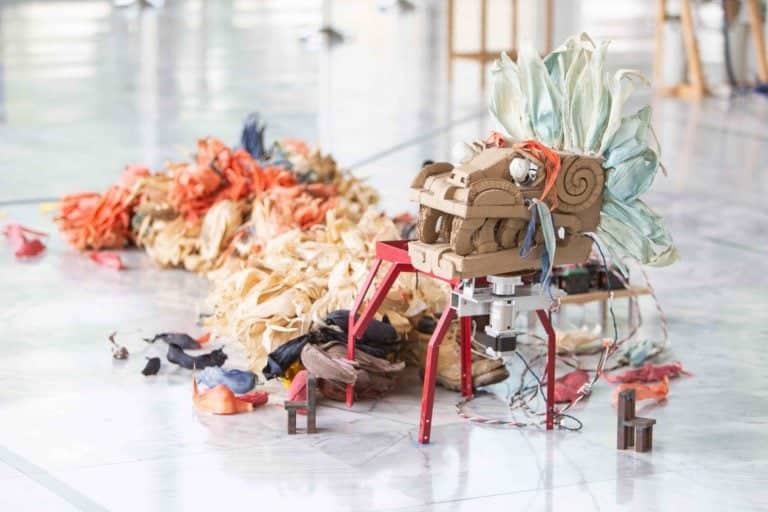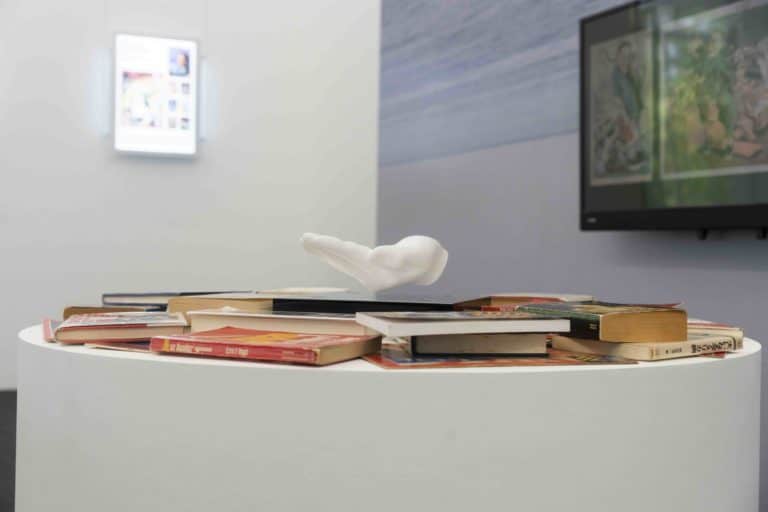A Singaporean artist, researcher, and educator, Salty Xi Jie Ng is no stranger to socially engaged art. It’s a natural extension of her artistic practice, best known for acute, witty, authentic commentary on various social issues.
Her most recent project, Both Sides, Now: tides 潮, features an art exhibition and community programmes co-created with eight senior collaborators from the neighbourhood of Yishun. This isn’t Ng’s first rodeo working with seniors—her previous projects include Not Grey: Intimacy, Ageing & Being (2021), a collaborative process that culminated in a collection of films, performances, and discussions, and The Grandma Reporter (2016–ongoing), a collaborative project on “senior women culture.”
She jokes: “Through all these projects, I always gain a group of older women in my life.”
Over the last few months, nestled within the community at the Wellness Kampung @ 765 Nee Soon Central in Yishun, Ng found herself working closely with eight intrepid senior collaborators to tackle challenging end-of-life conversations.
tides 潮 is a chapter in the end-of-life-focused Both Sides, Now programme by ArtsWok Collaborative. This arts-based community development organisation aims to empower individuals through the transformative power of the arts. What’s striking about tides 潮 is that most audiences are not privy to all of the art in the exhibition, as we could also consider the creative processes experienced by the collaborators as part of the artwork.
What is socially engaged art?
Socially engaged art, also known as socially engaged practice, is an art form that involves close collaboration with communities.
“It lives between art and life,” Ng shares, “and it’s a way of art-making that sees relationality (the social space and shared experience), as the art itself implies some level of participation and collaboration from people who are typically non-artists.” In other words, it isn’t just the final works that are the art here; the beauty lies within the process.
Ng explains there’s no hard and fast rule on how to do socially engaged art. “There might be dialogue, collective research, and exploration; it’s a lot about the process rather than just the outcome […] And it’s the opposite of making a work to be put in a gallery that has white walls and pretends to be a blank slate devoid of context.” From her perspective, this form of art is about creating “spaces where people can be themselves.”

Process as art
Given Ng’s practice as a cosmic scholar (a guide who provides spiritual readings), I was curious about her opinions on death.
“It’s a spiritual process,” she responds, reflecting on the vulnerability she expects to face when she eventually passes on. “And I think it’s exciting to think about what happens after death. Meditate with Guanyin as some Buddhists have told me? Do we live in the Taoist underworld? Waiting for our descendants to burn us paper money and presents?”
Ng’s metaphysical interests feel totally relevant to the exhibition’s subject matter: death, a topic that often feels too raw or taboo to tackle comfortably. She clarifies that she never imposed her views throughout the collaborative process—but her beliefs (along with an open-minded attitude) positioned her well to relate to the collaborator’s different stories and concerns.
I thought her response here exemplified her exploratory approach throughout the project’s development. While she’s credited as the lead artist, it might be best also to describe Ng as a guide, a facilitator. Rather than dictating the outcomes, she spent a great deal of care creating a safe environment for her collaborators to walk through their thoughts. “It feels like we’re going into this cave together […] It’s a real privilege to be able to sit in that space with them and take on that role of being a co-artist,” Ng shares.
What struck me throughout our conversation was the sheer amount of respect, sensitivity, and non-judgement Ng offered throughout the exhibition’s development. Rather than rushing into developing a concept and deciding on the artistic outcomes, she took great care to get to know each collaborator individually. The project’s earlier phases involved group sessions and personal phone calls with the collaborators. “The phone chats allow[ed] us to develop our relationship with each other […] while the group sessions built connection and trust among everyone,” Ng explains.
To her, as with all her projects, it feels like fate brought her and her collaborators together. Despite this project being their first time engaging in a social art form, I was surprised to learn how open the collaborators were to embarking on it. Ng explains that despite each collaborator’s unique personality, “the thing common between them is that they are all willing and curious to discuss end-of-life matters.” This openness was essential to the project’s success.

However, the process was not without its challenges. As Ng explains, the exhibition was just as much about unlearning as it was about learning. For one, “most people in the world don’t grow up thinking they have artistic abilities.” She adds that her collaborators come from “a generation of women that have been told that they are less important […] so there’s a lot of unlearning to do. And I think they’re all really brilliant […] and that [brilliance] takes reminding them sometimes.”
An earnest journey into artmaking and self-expression
During our conversation, Ng shared several anecdotes from the art-making process, illustrating the great care and attention she gave to the collaborators. For instance, upon realising that collaborators Chia Yim Fong, Koh Tong Cheng, and Michelle Sim only learnt to swim at an older age, she began piecing their narratives together in a script, which eventually evolved into an entire production filmed in the pool and entitled Float Free. During the post-production process, she discovered that the collaborators also attended the same vocal and breathing class. Coincidentally—or, arguably, as fate would have it—their teacher, Namira Rasman, was also a musician and sound artist. Ng saw an opportunity for the collaborators to incorporate their voices into the film’s score—applying their learning to the film. This creative decision enabled the collaborators to express themselves at every production stage. The result is a hauntingly beautiful soundscape that engulfs the listener, imitating the sensation of being submerged underwater. The voices are reminiscent of a choir, and hearing the soundtrack evokes a sense of freedom.

With the collaborator Lim Soh Joo decked in a get-up that features a whimsical headpiece made of wire and foil, and nestled comfortably in a booth decorated with her existential questions, Who Can Tell Me? (2024) is a visual standout. Ng describes Lim’s work as “the most unusual of the lot.” Upon realising how many existential questions Lim had—including “Where does [the soul] go when we die? Is there heaven?” or “Are we descendants of outer space beings?—Ng suggested that they channel that curiosity into the final work, conceptually centring it around Lim’s various questions.
While the questions printed on her booth’s fabric walls and the surrounding vibrant images of Soh against a cosmic background are provocative on their own, the performative aspect of the work is far more fascinating. Playing off Lim’s curiosity, Who Can Tell Me? invites visitors into her booth to indulge in existential conversations and offer answers to her questions.

Socially engaged art’s impact and value
While the word “art” typically brings to mind paintings, sculptures, or installations, Ng describes socially engaged art as the opposite of a spectacle: “[I]t’s about that very juicy and alive ecology of relations and shared experiences we’re having together.” In other words, the art lies in the interconnectedness and nuance we experience in life: its highs and lows, our personal interactions, the mundane yet crucial moments that occur in between life’s sporadic spectacles.
For those involved, social art can have a very healing effect. One of the collaborators in tides 潮 even described the project as a “turning point” in her life. “[T]he project, I think, gives them [the senior collaborators] the space to share things they had never really shared before, and discuss end-of-life matters with their peers,” Ng explains, “[One of the collaborators] told me that her interactions with me and with the project gave her a sense of self-worth and dignity.”
These heartfelt dialogues facilitate learning and reflection for Ng as well. “I feel like they’re teaching me how to age, and in some way, I’m preparing for my old age through all this work.”
Throughout our chat, Ng recounts many warm memories from all her past experiences working with seniors—absurd conversations about intimacy, the melancholy felt upon hearing one collaborator share her eulogy, and even writing senior erotica together. She expresses her desire to tackle more topics—such as artistic labour, or furthering her discussions on senior intimacy—illustrating and emphasising the art form’s capacity to uncover different life perspectives.
Socially engaged art often makes its participants come face-to-face with their humanity—rather than focusing only on aesthetic “beauty,” it creates profound experiences and relationships for the communities it engages. In a city like Singapore, where we’re often caught up in the hustle and bustle of city life, where conversations about mental health are much needed, and where many topics still feel taboo, socially engaged art presents itself as a powerful conduit for these crucial conversations and as a space for deep introspection.
_______________________________
tides 潮 runs at the Wellness Kampung @ 765 Nee Soon Central until 20 March 2024. Visit the website for more details and follow ArtsWok Collaborative on Instagram for the latest updates.
Read about another unique piece of socially-engaged art—a functioning provision shop!—here.
Header image: Salty Xi Jie Ng (centre) with Both Sides, Now collaborators Koh Tong Cheng (left), and Chia Yim Fong (right) during a group activity. Image via Stacy Huang.











